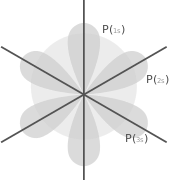Comprisation PART TWO
Alchemy of Order
April, 2024

Previously on Comprisation...
In Part One we were teased with promise of exploring "divine symmetry," perhaps guided by Sir Issac Newton himself. Instead we got dragged into a golf tournament problem. Let's reflect and see what Comprisation reveals about Alchemy.
Secrets are Hidden
"Occult" is a term we currently associate with the supernatural; with magical beliefs and practices. But technically it means "shut off from view." This can mean that something else is blocking our sight, or a thing may be intentionally hidden, or it may have just been lost.
The association with objects intentionally "hidden" suggests they are of great importance. We "hide" treasures, hoping to keep them safe for future retrieval by ourselves or someone deemed worthy. Or we hide dangerous things to protect the unprepared or to protect ourselves from incrimination. Much Alchemical investigation was done in secret, perhaps for both reasons.
Misplaced items are considered lost, but wisdom lost to antiquity is not merely misplaced. It is lost through appropriation, dissipation; through re-branding and re-blending. Evidenced by the Ancient Ruins, Great Architects of the past have left shadows of their achievements. The banner image above has a backdrop of a page from an unpublished Newton manuscript, attempting to define the dimensions of the Great Pyramid of Egypt. It was auctioned by Sothebys and accompanied with this (excerpted) description.
"Newton was certainly not alone in believing that the ancient Egyptians had access to profound knowledge that was lost to the modern world. The searching out of ancient occult secrets was a central trope of alchemy, a subject which Newton studied deeply. These notes reveal Newton seeking out an underlying structure to the pyramid: the unit of measurement used by its builders. Newton believed it likely that the ancients had been able to measure the Earth using techniques lost to modern man. [I]t is likely that when making these notes he hoped that the pyramid would give him the measure of the Earth and prove gravitational theory."
—Sothebys Auction Notes, 2020
It can be hard to tell how work on one problem provides inspiration to another, but I don't believe, in the end, Newton established a rational connection between Giza and F = G(m1m2)/R2.
Navigation Requires Vision
Neither buried nor lost to time, some things are "hidden in plain sight."

The last "Occult" category, occlusion, is where I see the connection to Comprisation.
The study of Combinatorics (combinations and permutations) began in Ancient History, and had a revival during the Renaissance. Both predicting and producing all the ways a set of elements can be ordered is straight forward. The number of permutations for {A, B, C, D} is 4! (4x3x2x1 = 24) and it looks like this:
ABCD BCDA CDAB DABC
ABDC BCAD CDBA DACB
ACBD BDAC CABD DBCA
ACDB BDCA CADB DBAC
ADCB BACD CBDA DCAB
ADBC BADC CBAD DCBA
There is no wrong turn possible there. A mistake would be obvious and even if a person missed a particular grouping, or duplicated one, it would be seen by others.
I consider that a single dimension scenario. An expanded (but common) challenge would be "26 letters, taken four at a time." That scenario produces all the letter groupings above PLUS all additional grouping involved with substituting one of the remaining 22 letters. I'm not going to populate them here, but math from Part One shows the total would be (26x25x24x23) or 385,800 groups. This is more involved, but also straightforward.
Comprisation comes to play when you say additionally, "Sure, create every unique group of four letters, pulling from the larger group of 26, but order within the group no longer makes it unique, AND AT THE SAME TIME ALL of the remaining 22 letters also have to be arranged into unique groups of 4, and the uniqueness is global across every time you attempt to do this.
When you extend this challenge to the full golf tournament structure, another dimension is added: "And with every combination of 4, no two letters can ever have occurred in the same group of four."
Instead of being a straightforward path, combining individual elements, Comprisations require an overhead map. They are occult in that you become blinded by otherwise legitimate paths. Comprisation offers a maze of dead ends that present as finished solutions.
Stars Hold our Destiny
"As Above, So Below" is the motto best associated with Alchemy and the Hermetic tradition. It's also a sort of branching off point where Science and Mysticism went their separate ways. The personal, spiritual, and SUBJECTIVE nature of Mysticism creates a Freudian-repression regarding Alchemy. If Alchemy contributes mystically we assume it cannot contribute objectively. The "baby gets thrown out with the bath water."
However, the greatest thinkers have long recognized validity in the Macrocosm/Microcosm relationship.

"Say first, of God above, or man below,
What can we reason, but from what we know?
He, who through vast immensity can pierce,
See worlds on worlds compose one universe.
Observe how system into system runs,
What other planets circle other suns"
—Alexander Pope, from Essay on Man, 1733

Model of the Atom has Since "Evolved"

Wikipedia has an article on Niels Bohr, including the excellent infographic above. The Bohr model of the atom is still taught today, while also mentioning "it's wrong." Moving from left to right on the infographic, Thompson's "Plum Pudding Model", Rutherford's Model, Bohr's Model, and the current Heisenberg/Schrödinger (Quantum) Model.
I was hunting for a quote from Bohr about how an atom was like the solar system, but he was very cagey and deeply influenced by quantum physics (far right model). Fortunately, the Rutherford model came before Bohr's and symbolically represents how the atom is commonly displayed today:

Rutherford, however, gives credit to Perrin, who was more than happy to mention "planetary electrons" orbiting a positive "Sun" in his Nobel acceptance speech. A unapologetically "Hermetic" approach.
The connection of these models takes an interesting turn back toward, rather than away from Alchemy and Mysticism. The Heisenberg model is full of "indeterminism," "probability," "uncertainty," and "depends on the observer" statements. Mystics soon embraced this to claim "Science Proves there is no Objective Truth!"

Heisenberg and Schrödinger were both fans of Eastern Philosophy and many of their quotes demonstrate this. However, they would not support the subsequent "Quantum Mysticism Movement," instead, formalizing that while "Quantum mechanics is intrinsically indeterministic...wave functions are objective...they do not depend upon personal opinions of individual physicists or other such arbitrary influences."
So if you are meditating on illustrations of "Sacred Geometry," coupled by written "Statements of Intention," you are practicing a form of Mystical Witchcraft, and not utilizing Quantum Science. If we are looking for a lasting division between Objectivity and Magical Thinking, that demarkation is Subjective "Wish Manifestation." But that doesn't preclude an objective search for the "Divine Symmetrical Arrangement of Elements."
Reality is Generated from Elemental Symmetries
When I saw this illustration of the Heisenberg Quantum Model I was taken aback.

Like noticing a "glitch in the matrix," I had just yesterday come across this pattern, supporting Robert Grant's video on a GIZA - The Holy Grail of Geometry. Grant, if you recall, created the 24-slice "Grant Wheel," which I critiqued as an impetus for my previous article, The Numbers.
Grant's geometric connection to the Egyptian Pyramids comes from a pattern called "Metatron's Cube." We will go over this design and it's connection to Newton and the Quantum model in "Comprisation PART THREE."